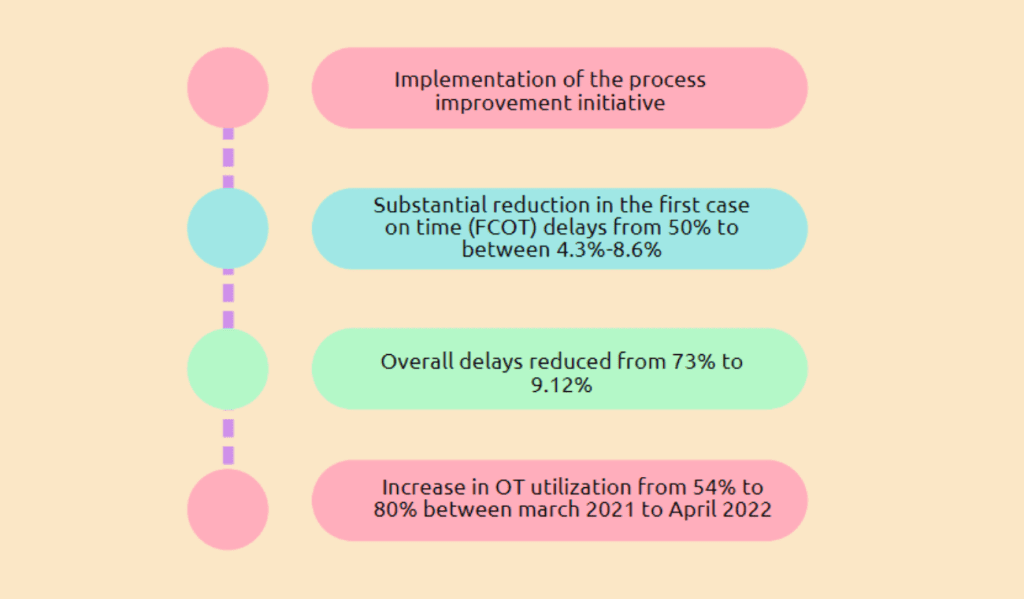FCOT: Tackling First Case On-Time(FCOT) A Win- Win For Patients, Surgeons & Organization
Read the Magazine in PDF
Abstract:
This article focuses on the initiative Sir H. N. Reliance Foundation Hospital took to address the issue of delayed surgery slots and improve the efficiency of their operating rooms (OTs). The project aimed to reduce delays in the first case and maximize OT utilization. Through implementing various strategies and process improvements, significant progress was made in reducing delays and enhancing overall efficiency. The project followed the FOCUS PDCA methodology and employed tools like fishbone analysis to identify root causes and develop targeted solutions. So far, The results have been promising, leading to improved patient satisfaction, optimized resource utilization, and enhanced coordination between teams. The success of this project has also inspired the hospital to replicate similar improvements in other departments, such as the cath lab, to ensure consistent, high-quality care delivery.
Organization Profile
Sir H. N. Reliance Foundation Hospital in South Mumbai is a quaternary care facility with 345 beds. Its primary objective is to provide safe, accessible, and top-notch healthcare services to all segments of society, employing international evidence-based practices, a highly skilled workforce, well-trained staff, and state-of-the-art technology. The hospital has received prestigious accreditations from JCI (the Joint International Commission) and NABH, signifying its commitment to delivering quality care and ensuring patient safety. Furthermore, it is the largest Gold Certified Green Hospital in Mumbai, complying with national and international standards for sustainable and environmentally friendly building practices.
Introduction:
Delayed movement of surgery slots results in dissatisfaction among consultants, staff, and patients and generates undue anxiety in patients. From a business perspective, running operation theatres (OTs) is costly, and several factors impact their efficiency.
A delay in the first case can lead to reduced utilization of operating rooms and increased facility costs. Each hour lost in the OR incurs a financial loss of Rs. 8,000 per room. Given the monthly rise in OR utilization, ensuring the punctuality of the first case has become crucial. To address this issue, a multidisciplinary team comprising medical operations, nursing, laboratory, and radiology was assigned to the project.
In January 2021 and February 2021, the overall delay for timely wheel-in in the operating room (OR) was 73% and 67%, respectively. However, starting in March, the focus shifted to tracking and addressing first-case delays exceeding 15 minutes. These delays were found to range from 37% to 50%.
The overall delay for patient wheeling in the operating theatre (OT), comparing scheduled time to wheel-in time exceeding 15 minutes, was 73% in January 2021 and 67% in February 2021. Out of an average of 22 cases per day, approximately 16 cases experienced delays of more than 15 minutes, resulting in a total daily delay of around 4 hours. This overflow of cases beyond the allotted resource hours increased work hours and overtime duties in certain OTs. Furthermore, first-case delays ranged from 37% to 50%, emphasizing the need to address this issue. The project employed the FOCUS PDCA methodology, including fishbone analysis to identify causes, set objectives and targets, and develop and execute a new process map. Thus, the aim of the study was to ensure the first cases started on time, standardize and provide visibility on key operational indicators and maximize OT utilization. Moreover, the targets were focused on reducing first-case delays to less than 5% (achieving>90% FCOTs) and increasing OT utilization to over 75%.
Outcome:
Based on the root causes identified, the following actions were taken:
- Pharmacy Kits:
- Assigned an OT nurse responsible for coordinating and receiving pharmacy kits on time.
- Implemented a pre-check for kit completeness at night.
2. COVID Testing:
- Ensured strict compliance with RT-PCR report availability by checking on admission.
- Conducted a check with the lab team one day before surgery readiness.
3. CSSD Instruments:
- Assigned an OT nurse responsible for optimizing the mobilization of instruments to improve turnaround time (TAT).
- Conducted OT round-ups twice with CSSD technicians.
4. Doctors/Residents:
- Conducted sensitization sessions for doctors and residents.
- Residents were made responsible for coordinating and maintaining the schedule, being present in the OT 20 minutes before the scheduled time, and informing the surgeon.
- Identified a Single Point of Contact (SPOC) in each surgical speciality to address concerns and ensure proper communication and closures.
5. Patient Admission:
- Called patients 48 hours before surgery for confirmation.
- Scheduled the admission of all morning surgeries one day prior or at least 2 hours before surgery.
- Informed residents in advance about early morning admissions.
6. Pre-op Preparation:
- The Nursing Night Supervisor checked and coordinated the readiness of the next day’s surgical cases.
- Shared a status update about all OT patients at 6:30 am with all stakeholders to address any pending activities.
- Ensured patients were shifted to the OT 30 minutes before the scheduled time.
7. OT Booking:
- Implemented a uniform and accurate OT slot scheduling system to avoid under/overbooking.
- Made a call to the surgeon one day before the scheduled case to confirm the appointment.
- Implementing these measures aimed to address the root causes and improve the efficiency and timeliness of the first case in the operating theatre.
Ensuring the sustainability of the improvement measures:
During the ‘Do’ phase, a dashboard was developed to monitor the daily percentage of First Case On Time (FCOT) delays. This dashboard was shared with the team as feedback on their actions. The group actively engaged in brainstorming sessions to identify and address any barriers encountered during the implementation process. The team resolved these barriers daily to ensure continuous improvement and reduce FCOT delays. Thus, due to the increasing number of cases per day in the cath lab, a similar project is being implemented to replicate the successful process improvement initiative.
Tangible results include notable improvements in reducing First Case On-Time (FCOT) delays. This reduction in FCOT delays has consequently resulted in a decrease in overall delays.

The improvements mentioned have contributed to reducing delays in the following ways:

Conclusion:
The efforts made by Sir H. N. Reliance Foundation Hospital to tackle first-case delays in their operating rooms have yielded substantial improvements. Implementing targeted interventions and establishing a multidisciplinary team have reduced FCOT delays from 50% to between 4.3% and 8.6%. This reduction has translated into an overall decrease in delays from 73% to 9.12%. Additionally, OT utilization has increased from 54% to 80% between March 2021 and April 2022, indicating improved operational efficiency and resource management. The success of this project not only benefits patients and surgeons by minimizing delays and anxiety but also brings organizational benefits by optimizing resource utilization and maintaining overbooking and underbooking at optimal levels. The enhanced coordination between teams has further streamlined the system, fostering efficiency and effectiveness in delivering healthcare services. The hospital plans to sustain and replicate these improvements in other departments, ensuring a consistent culture of excellence and patient-centred care.




